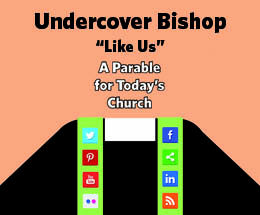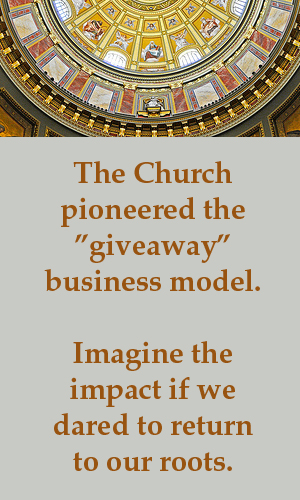2×2 has been experimenting with Social Media as a ministry tool for nearly three years.
During this time, Social Media made significant strides in gaining stature in every walk of life. When we started our experiment, many in the business world and nonprofit worlds were still not sold on doing more than hosting a barebones website as their nod to the modern world.
It’s safe to say at this point that every business or service sector is now ready to admit that Social Media is here to stay and that smart operators are investing in their web presence beyond their static website. It’s all but universal. A major holdout is — you guessed it — the Church.
The Church remains outside looking in, unable to fit the new way of doing things into their outdated structure.
Here is the status of the congregations and social media in our experience.
2×2 is a project of Redeemer Lutheran Church in East Falls. The Southeastern Pennsylvania Synod of the Evangelical Lutheran Church in America claimed our land and decided four years ago that they are better stewards of our resources. While the property provided for mission by the Lutherans of East Falls remains idle and locked to all mission, the people of Redeemer have continued their innovative ministry with visits to other churches and experimentation with Social Media.
This is what we’ve seen in our 76 church visits to half the churches in our synod. (Some churches we visited house two ministries.)
About 90% of the Lutheran churches in our area have some sort of website. It is amazing that there are still ANY churches that have NO web presence. It gets easier every day and costs less than $50 per year.
In today’s world, a congregation’s failure to provide basic information online is advertising that they are not invested in evangelism. Failure to have a website is akin to a hospital staff “calling a code.”
Of the 90% that have websites, there are less than 5% using their site for more than a brochure about their church—the ALL ABOUT US approach to Evangelism. There is practically no inbound content—content that would attract seekers and is designed to be helpful to OTHERS as opposed to tooting the congregation’s horn. It is commendable that people in their neighborhoods can look up worship times and see who the pastor and staff are, but they are missing the true value of having a website—evangelism.
A few pastors have attempted blogs. Most quit after a few posts. The pastor at St. Andrew’s, Audubon, is one of the few pastors who seems to be ready to lead the church in using the web as an education and evangelism tool. One church, St. Michael’s in Unionville, invested in a modern web presence but opted to outsource the development of content—so it has a generic feel to it. It would probably be worth the investment of having a dedicated social media leader on staff to get full benefit of their investment. Trinity, Lansdale, hired a part-time communications director. That’s a step in the right direction.
A few churches actively use Facebook to create community. Most tend to use their Facebook page as a bulletin board.
Practically no churches use Twitter. Twitter has a great track record of “finding” people. This is a tool that is greatly misunderstood but which could very much benefit ministry.
SEPA Synod is trying to use Facebook but they haven’t been getting much traction. Interestingly they posted an article yesterday.
It starts:
Friday Food for Thought: What does an institution due [sic] faced with red ink and a dwindling, aging audience? Keep true to its core while driving innovation, embracing the possibilities of technology and reaching out to new audiences.
They pose this question and then point readers to a video clip from CBS’s 60 Minutes about the Metropolitan Opera’s solution to a similar challenge.
We know very well SEPA’s solution to their own question. They ignore congregation’s that innovate, sue their members and claim their land for their own enrichment.
It’s interesting, however, to see that they recognize innovation outside of their own sphere.
The challenge to virtually every congregation is in recognizing that Social Media has value requiring expertise that should be compensated. Frankly, Social Media will go farther to reviving ministry than even the best organists/music directors, education directors or even (dare we say it) clergy, in many cases.
Every month that goes by without any attempt to move all congregations in this direction is time spent talking about innovation and doing nothing to make it happen.
This is probably why innovation is so slow. In business, success depends on innovation and reaching people. Even CEO’s that are resistant to change can look at the numbers and make decisions that will keep their organizations viable.
In the Church, however, clergy play a leadership role that can go on for many years while the statistics of their ministry fail, without any pressure to change—until it is too late and the congregation can no longer pay clergy salaries. Then the congregations are seen as the failures. The clergy move on to somewhere they can continue doing things the same way until the money runs out again. When that gets too frustrating, they sign up for interim training.
Most clergy have no training in media. Failure to have these skills today is like not being able to read! Any church that calls a pastor who cannot use modern tools and is resistant to anyone else using this is doomed to status quo or failure.
Unfortunately, the role of Social Media director of communications director is likely to be seen as competitive with the role of clergy. So nothing will change.
Then there is Redeemer’s ministry—which SEPA was united in working for the last seven years to destroy. Redeemer stands alone in having made the investment in true innovation. Our work has positioned our congregation to truly lead in creating a platform and funding source for small congregational ministry.
We discovered that using Social Media IS transforming. It is not an optional “add on” but will shape your community and your potential. Church will be different. Ministry will be different. It is likely that the differences will be what the doctor ordered a long time ago!
We could help SEPA congregations join in our success to the benefit of all. But that would require that SEPA recognize Redeemer. Heaven forbid!
More’s the pity!
Related posts:
14 Reasons Congregations Should Avoid Social Media Ministry
9 Reasons Every Congregation Should Have A Social Media Committee




